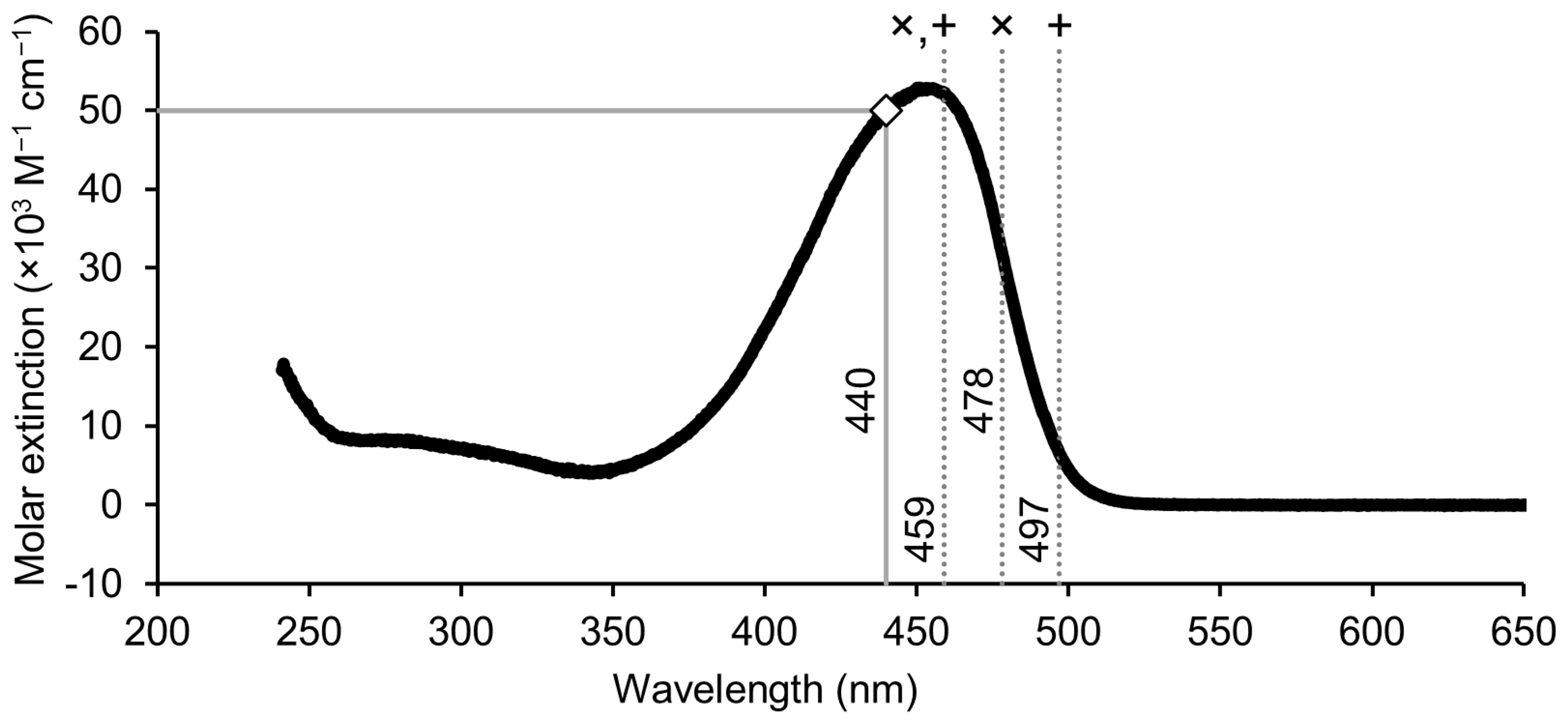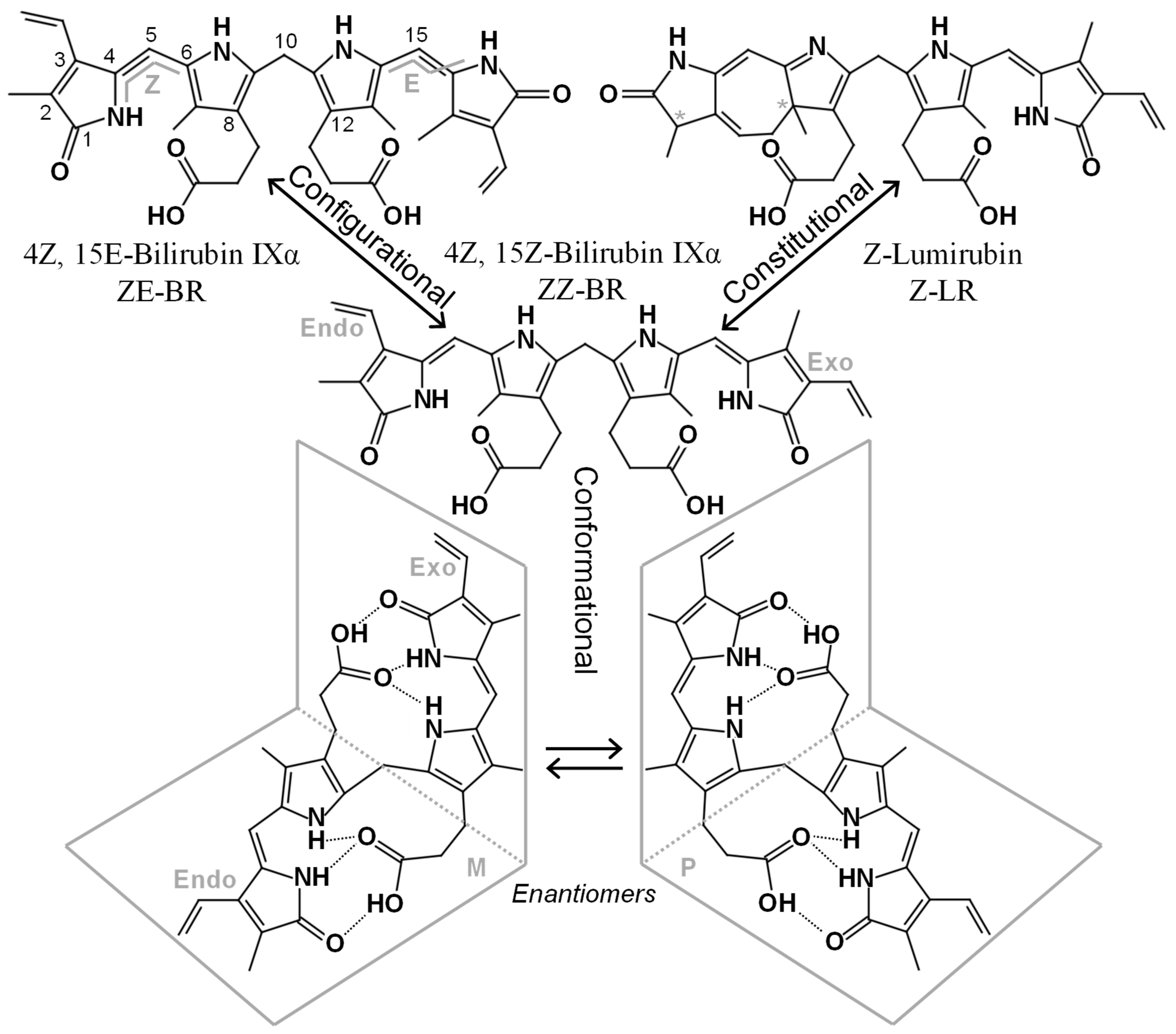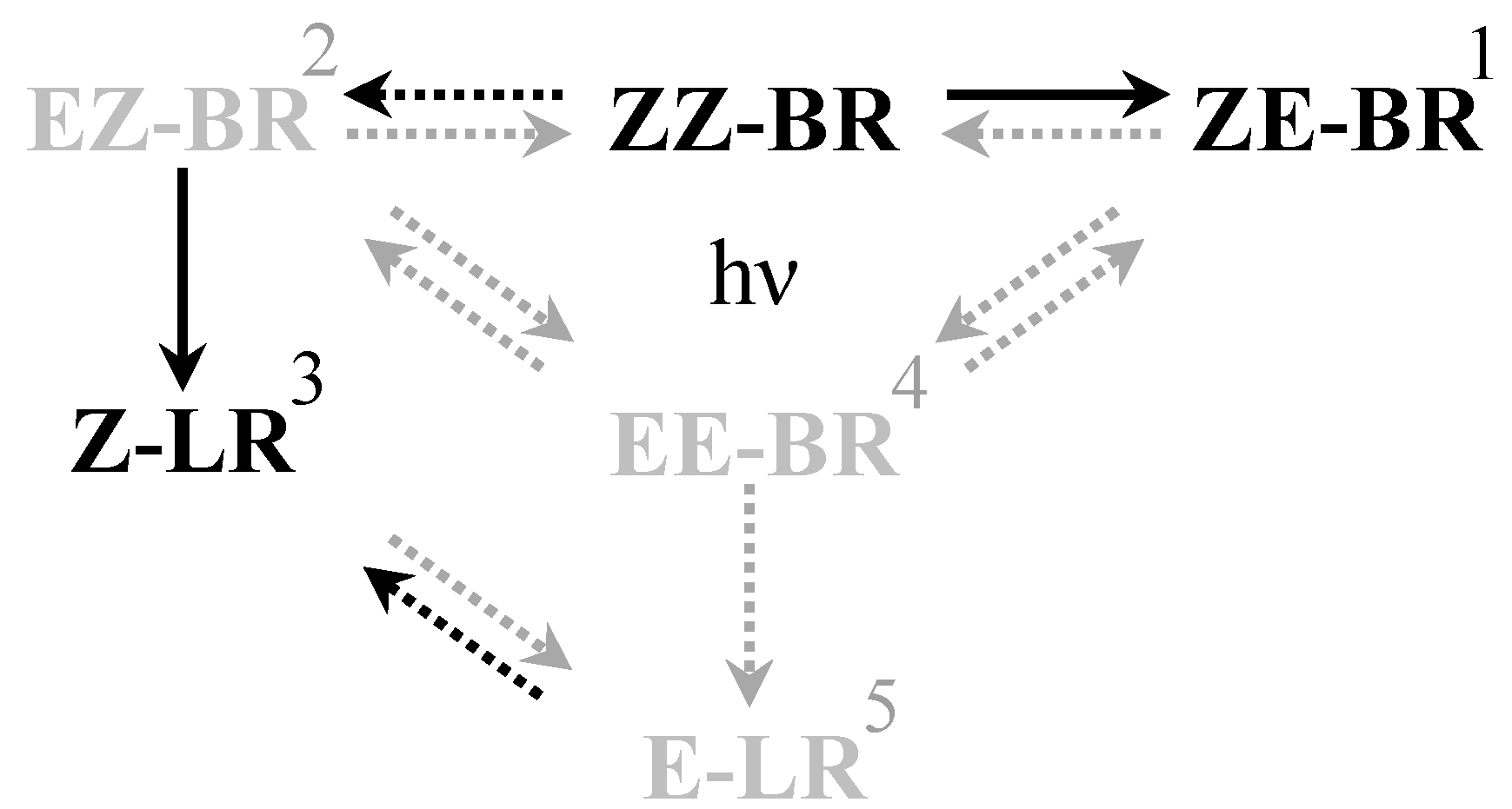Bilirubin Photoisomers in Neonatal Jaundice
Abstract
1. Introduction
2. Chemistry of Photoisomers
| Isomerization | Product | Reversibility | Solubility | Excretion Route | Clearence * /Half-Life | Clinical Role | Ref |
|---|---|---|---|---|---|---|---|
| Conformational | P and M ZZ-BR | Dynamic Equilibrium | Low | Bile, following conjugation | 2% day−1 preterm 11% day−1 full-term | Slow excretion Passage through BBB | [14,15,19] |
| Configurational | ZE-BR EZ-BR (EE-BR) | Reversible | Moderate | Urine + bile | t1/2 = 15 h | Enhances excretion | [20,21,22] |
| Constitutional | Z-LR (E-LR) | Practically Irreversible | Moderate High | Urine + bile | t1/2 = 2 h | Main route for permanent clearance | [9,10,12,22] |
3. Clinical Implications of PT on Photoisomers
3.1. Wavelength Considerations in PT

3.2. Photoisomer–Albumin Interaction
3.3. Toxicity of Photoisomers
4. Quantification of Bilirubin and Its Photoisomers
4.1. Impact on Routine Clinical TBIL Assays
4.2. Quantitative Analysis of Photoisomers
5. Future Perspective
Analysis of Urinary Photoisomers
Funding
Institutional Review Board Statement
Informed Consent Statement
Data Availability Statement
Acknowledgments
Conflicts of Interest
References
- Cremer, R.J.; Perryman, P.W.; Richards, D.H. Influence of light on the hyperbilirubinaemia of infants. Lancet 1958, 271, 1094–1097. [Google Scholar] [CrossRef] [PubMed]
- Ferreira, H.C.; Cardim, W.H.; Mellone, O. Phototherapy. A new therapeutic method in hyperbilirubinemia of the newborn. J. Pediatr. 1960, 25, 347–391. [Google Scholar]
- Lucey, J.; Ferreiro, M.; Hewitt, J. Prevention of hyperbilirubinemia of prematurity by phototherapy. Pediatrics 1968, 41, 1047–1054. [Google Scholar] [CrossRef]
- Scheidt, P.C.; Bryla, D.A.; Nelson, K.B.; Hirtz, D.G.; Hoffman, H.J. Phototherapy for Neonatal Hyperbilirubinemia—6-Year Follow-up of the National-Institute-of-Child-Health-and-Human-Development Clinical-Trial. Pediatrics 1990, 85, 455–463. [Google Scholar] [PubMed]
- Bergman, D.A.; Cooley, J.R.; Coombs, J.B.; Goldberg, M.J.; Homer, C.J.; Nazarian, L.F.; Riemenschneider, T.A.; Roberts, K.B.; Shea, D.W.; Tonniges, T.F.; et al. Practice Parameter—Management of Hyperbilirubinemia in the Healthy Term Newborn. Pediatrics 1994, 94, 558–565. [Google Scholar]
- Morris, B.H.; Oh, W.; Tyson, J.E.; Stevenson, D.K.; Phelps, D.L.; O’Shea, T.M.; McDavid, G.E.; Perritt, R.L.; Van Meurs, K.P.; Vohr, B.R.; et al. Aggressive vs. conservative phototherapy for infants with extremely low birth weight. N. Engl. J. Med. 2008, 359, 1885–1896. [Google Scholar] [CrossRef]
- Jasprová, J.; Dal Ben, M.; Hurny, D.; Hwang, S.; Zízalová, K.; Kotek, J.; Wong, R.J.; Stevenson, D.K.; Gazzin, S.; Tiribelli, C.; et al. Neuro-inflammatory effects of photodegradative products of bilirubin. Sci. Rep. 2018, 8, 7444. [Google Scholar] [CrossRef]
- Mujawar, T.; Sevelda, P.; Madea, D.; Klan, P.; Svenda, J. A Platform for the Synthesis of Oxidation Products of Bilirubin. J. Am. Chem. Soc. 2024, 146, 1603–1611. [Google Scholar] [CrossRef]
- Ennever, J.F.; Costarino, A.T.; Polin, R.A.; Speck, W.T. Rapid Clearance of a Structural Isomer of Bilirubin during Phototherapy. J. Clin. Investig. 1987, 79, 1674–1678. [Google Scholar] [CrossRef]
- McDonagh, A.F. Bilirubin photo-isomers: Regiospecific acyl glucuronidation in vivo. Monatshefte Fur. Chem. 2014, 145, 465–482. [Google Scholar] [CrossRef]
- Vreman, H.J.; Kourula, S.; Jasprová, J.; Ludvíková, L.; Klán, P.; Muchová, L.; Vítek, L.; Cline, B.K.; Wong, R.J.; Stevenson, D.K. The effect of light wavelength on in vitro bilirubin photodegradation and photoisomer production. Pediatr. Res. 2019, 85, 865–873, Correction in Pediatr. Res. 2019, 85, 905. [Google Scholar] [CrossRef]
- Uchida, Y.; Takahashi, Y.; Kurata, C.; Morimoto, Y.; Ohtani, E.; Tosaki, A.; Kumagai, A.; Greimel, P.; Nishikubo, T.; Miyawaki, A. Urinary lumirubin excretion in jaundiced preterm neonates during phototherapy with blue light-emitting diode vs. green fluorescent lamp. Sci. Rep. 2023, 13, 18359. [Google Scholar] [CrossRef]
- Takahashi, M.; Sugiyama, K.; Shumiya, S.; Nagase, S. Penetration of Bilirubin into the Brain in Albumin-Deficient and Jaundiced Rats (Ajr) and Nagase Analbuminemic Rats (Nar). J. Biochem. 1984, 96, 1705–1712. [Google Scholar] [CrossRef]
- Wennberg, R.P. The blood-brain barrier and bilirubin encephalopathy. Cell. Mol. Neurobiol. 2000, 20, 97–109. [Google Scholar] [CrossRef] [PubMed]
- Lightner, D.A.; Reisinger, M.; Landen, G.L. On the Structure of Albumin-Bound Bilirubin—Selective Binding of Intramolecularly Hydrogen-Bonded Conformational Enantiomers. J. Biol. Chem. 1986, 261, 6034–6038. [Google Scholar] [CrossRef] [PubMed]
- Moss, G.P. Basic terminology of stereochemistry. Pure Appl. Chem. 1996, 68, 2193–2222. [Google Scholar] [CrossRef]
- McDonagh, A.F.; Assisi, F. Ready Isomerization of Bilirubin-IX-Alpha in Aqueous-Solution. Biochem. J. 1972, 129, 797–800. [Google Scholar] [CrossRef]
- McDonagh, A.F. Ex uno plures: The concealed complexity of bilirubin species in neonatal blood samples. Pediatrics 2006, 118, 1185–1187. [Google Scholar] [CrossRef]
- Ullrich, D.; Fevery, J.; Sieg, A.; Tischler, T.; Bircher, J. The Influence of Gestational-Age on Bilirubin Conjugation in Newborns. Eur. J. Clin. Investig. 1991, 21, 83–89. [Google Scholar] [CrossRef] [PubMed]
- Ennever, J.F.; Knox, I.; Denne, S.C.; Speck, W.T. Phototherapy for Neonatal Jaundice—Invivo Clearance of Bilirubin Photoproducts. Pediatr. Res. 1985, 19, 205–208. [Google Scholar] [CrossRef]
- Itoh, S.; Onishi, S. Kinetic study of the photochemical changes of (ZZ)-bilirubin IX alpha bound to human serum albumin. Demonstration of (EZ)-bilirubin IX alpha as an intermediate in photochemical changes from (ZZ)-bilirubin IX alpha to (EZ)-cyclobilirubin IX alpha. Biochem. J. 1985, 226, 251–258. [Google Scholar] [CrossRef]
- Onishi, S.; Kawade, N.; Itoh, S.; Isobe, K.; Sugiyama, S. High-Pressure Liquid-Chromatographic Analysis of Anaerobic Photoproducts of Bilirubin-Ix-Alpha Invitro and Its Comparison with Photoproducts Invivo. Biochem. J. 1980, 190, 527–532. [Google Scholar] [CrossRef]
- Bhutani, V.K.; Wong, R.J.; Turkewitz, D.; Rauch, D.A.; Mowitz, M.E.; Barfield, W.D.; Eichenwald, E.; Ambalavanan, N.; Guillory, C.; Hudak, M. Phototherapy to prevent severe neonatal hyperbilirubinemia in the newborn infant 35 or more weeks of gestation: Technical report. Pediatrics 2024, 154, e2024068026. [Google Scholar] [CrossRef]
- Ebbesen, F.; Hansen, T.W.; Maisels, M.J. Update on phototherapy in jaundiced neonates. Curr. Pediatr. Rev. 2017, 13, 176–180. [Google Scholar] [CrossRef]
- Ebbesen, F.; Madsen, P.H.; Rodrigo-Domingo, M.; Donneborg, M.L. Bilirubin isomers during LED phototherapy of hyperbilirubinemic neonates, blue-green (∼478 nm) vs blue. Pediatr. Res. 2024, 97, 1623–1628. [Google Scholar] [CrossRef]
- Cruz, A.B.; de Brito, L.G.; Leal, P.V.B.; Ramos, W.T.D.; Pereira, D.H. Intramolecular hydrogen bonds interactions in the isomers of the bilirubin molecule: DFT and QTAIM analysis. J. Mol. Model. 2023, 29, 318. [Google Scholar] [CrossRef] [PubMed]
- Troup, G.J.; Agati, G.; Fusi, F.; Pratesi, R. Photophysics of the variable quantum yield of asymmetric bilirubin. Aust. J. Phys. 1996, 49, 673–681. [Google Scholar] [CrossRef]
- Ebbesen, F.; Madsen, P.H.; Vandborg, P.K.; Jakobsen, L.H.; Trydal, T.; Vreman, H.J. Bilirubin isomer distribution in jaundiced neonates during phototherapy with LED light centered at 497 nm (turquoise) vs. 459 nm (blue). Pediatr. Res. 2016, 80, 511–515. [Google Scholar] [CrossRef]
- Lamola, A.A. Effects of environment on photophysical processes of bilirubin. In Optical Properties and Structure of Tetrapyrroles; De Gruyter Brill: Berlin, Germany, 1985; pp. 311–326. [Google Scholar]
- Lamola, A.A.; Flores, J.; Doleiden, F.H. Quantum Yield and Equilibrium Position of the Configurational Photo-Isomerization of Bilirubin Bound to Human-Serum Albumin. Photochem. Photobiol. 1982, 35, 649–654. [Google Scholar] [CrossRef] [PubMed]
- Dixon, J.M.; Taniguchi, M.; Lindsey, J.S. PhotochemCAD 2: A Refined Program with Accompanying Spectral Databases for Photochemical Calculations. Photochem. Photobiol. 2005, 81, 212–213. [Google Scholar] [CrossRef]
- Du, H.; Fuh, R.C.A.; Li, J.Z.; Corkan, L.A.; Lindsey, J.S. PhotochemCAD: A computer-aided design and research tool in photochemistry. Photochem. Photobiol. 1998, 68, 141–142. [Google Scholar] [CrossRef]
- Lee, K.S.; Gartner, L.M. Spectrophotometric Characteristics of Bilirubin. Pediatr. Res. 1976, 10, 782–788. [Google Scholar] [CrossRef]
- Weisiger, R.A.; Ostrow, J.D.; Koehler, R.K.; Webster, C.C.; Mukerjee, P.; Pascolo, L.; Tiribelli, C. Affinity of human serum albumin for bilirubin varies with albumin concentration and buffer composition: Results of a novel ultrafiltration method. J. Biol. Chem. 2001, 276, 29953–29960. [Google Scholar] [CrossRef]
- Zunszain, P.A.; Ghuman, J.; McDonagh, A.F.; Curry, S. Crystallographic analysis of human serum albumin complexed with 4Z,15E-bilirubin-IXalpha. J. Mol. Biol. 2008, 381, 394–406. [Google Scholar] [CrossRef] [PubMed]
- Nii, K.; Okada, H.; Itoh, S.; Kusaka, T. Characteristics of bilirubin photochemical changes under green light-emitting diodes in humans compared with animal species. Sci. Rep. 2021, 11, 6391. [Google Scholar] [CrossRef]
- Cuperus, F.J.; Schreuder, A.B.; van Imhoff, D.E.; Vitek, L.; Vanikova, J.; Konickova, R.; Ahlfors, C.E.; Hulzebos, C.V.; Verkade, H.J. Beyond plasma bilirubin: The effects of phototherapy and albumin on brain bilirubin levels in Gunn rats. J. Hepatol. 2013, 58, 134–140. [Google Scholar] [CrossRef] [PubMed]
- Nagase, S.; Shimamune, K.; Shumiya, S. Albumin-deficient rat mutant. Science 1979, 205, 590–591. [Google Scholar] [CrossRef] [PubMed]
- Vodret, S.; Bortolussi, G.; Schreuder, A.B.; Jasprova, J.; Vitek, L.; Verkade, H.J.; Muro, A.F. Albumin administration prevents neurological damage and death in a mouse model of severe neonatal hyperbilirubinemia. Sci. Rep. 2015, 5, 16203. [Google Scholar] [CrossRef]
- Mitra, S.; Samanta, M.; Sarkar, M.; De, A.K.; Chatterjee, S. Pre-exchange 5% albumin infusion in low birth weight neonates with intensive phototherapy failure--a randomized controlled trial. J. Trop. Pediatr. 2011, 57, 217–221. [Google Scholar] [CrossRef]
- Shahian, M.; Moslehi, M.A. Effect of albumin administration prior to exchange transfusion in term neonates with hyperbilirubinemia--a randomized controlled trial. Indian Pediatr. 2010, 47, 241–244. [Google Scholar] [CrossRef]
- Dash, N.; Kumar, P.; Sundaram, V.; Attri, S.V. Pre exchange Albumin Administration in Neonates with Hyperbilirubinemia: A Randomized Controlled Trial. Indian Pediatr. 2015, 52, 763–767. [Google Scholar] [CrossRef]
- Magai, D.N.; Mwaniki, M.; Abubakar, A.; Mohammed, S.; Gordon, A.L.; Kalu, R.; Mwangi, P.; Koot, H.M.; Newton, C.R. A randomized control trial of phototherapy and 20% albumin versus phototherapy and saline in Kilifi, Kenya. BMC Res. Notes 2019, 12, 617. [Google Scholar] [CrossRef] [PubMed]
- Govaert, P.; Lequin, M.; Swarte, R.; Robben, S.; De Coo, R.; Weisglas-Kuperus, N.; De Rijke, Y.; Sinaasappel, M.; Barkovich, J. Changes in globus pallidus with (Pre) term kernicterus. Pediatrics 2003, 112, 1256–1263. [Google Scholar] [CrossRef]
- Kemper, A.R.; Newman, T.B.; Slaughter, J.L.; Maisels, M.J.; Watchko, J.F.; Downs, S.M.; Grout, R.W.; Bundy, D.G.; Stark, A.R.; Bogen, D.L.; et al. Clinical Practice Guideline Revision: Management of Hyperbilirubinemia in the Newborn Infant 35 or More Weeks of Gestation. Pediatrics 2022, 150, e2022058859. [Google Scholar] [CrossRef]
- Hansen, T.W.R.; Maisels, M.J.; Ebbesen, F.; Vreman, H.J.; Stevenson, D.K.; Wong, R.J.; Bhutani, V.K. Sixty years of phototherapy for neonatal jaundice–from serendipitous observation to standardized treatment and rescue for millions. J. Perinatol. 2020, 40, 180–193. [Google Scholar] [CrossRef] [PubMed]
- Hansen, T.W.R. Biology of bilirubin photoisomers. Clin. Perinatol. 2016, 43, 277–290. [Google Scholar] [CrossRef]
- Hansen, T.W.R. Phototherapy for neonatal jaundice—Therapeutic effects on more than one level? In Seminars in Perinatology; Elsevier: Amsterdam, The Netherlands, 2010; Volume 34, pp. 231–234. [Google Scholar]
- Capková, N.; Pospísilová, V.; Fedorová, V.; Raska, J.; Pospísilová, K.; Dal Ben, M.; Dvorák, A.; Viktorová, J.; Bohaciaková, D.; Vítek, L. The Effects of Bilirubin and Lumirubin on the Differentiation of Human Pluripotent Cell-Derived Neural Stem Cells. Antioxidants 2021, 10, 1532. [Google Scholar] [CrossRef] [PubMed]
- Doumas, B.T.; Wu, T.W.; Jendrzejczak, B. Delta-Bilirubin—Absorption-Spectra, Molar Absorptivity, and Reactivity in the Diazo Reaction. Clin. Chem. 1987, 33, 769–774. [Google Scholar] [CrossRef]
- Kiuchi, S.; Ihara, H.; Osawa, S.; Ishibashi, M.; Kinpara, K.; Ohtake, K.; Ida, T.; Miura, Y.; Fujimura, Y.; Ueda, S.; et al. A survey of the reactivity of in vitro diagnostic bilirubin reagents developed in Japan using artificially prepared bilirubin materials: A comparison of synthetic delta, unconjugated, and taurine-conjugated bilirubin. Ann. Clin. Biochem. 2021, 58, 563–571. [Google Scholar] [CrossRef]
- Kawamoto, S.; Koyano, K.; Ozaki, M.; Arai, T.; Iwase, T.; Okada, H.; Itoh, S.; Murao, K.; Kusaka, T. Effects of bilirubin configurational photoisomers on the measurement of direct bilirubin by the vanadate oxidation method. Ann. Clin. Biochem. 2021, 58, 311–317. [Google Scholar] [CrossRef]
- Okada, H.; Itoh, S.; Kawamoto, S.; Ozaki, M.; Kusaka, T. Reactivity of bilirubin photoisomers on the measurement of direct bilirubin using vanadic acid method. Ann. Clin. Biochem. 2018, 55, 296–298. [Google Scholar] [CrossRef] [PubMed]
- Itoh, S.; Kusaka, T.; Imai, T.; Isobe, K.; Onishi, S. Effects of bilirubin and its photoisomers on direct bilirubin measurement using bilirubin oxidase. Ann. Clin. Biochem. 2000, 37, 452–456. [Google Scholar] [CrossRef] [PubMed]
- Kawaguchi, N.; Koyano, K.; Morita, H.; Fadly, D.; Shinabe, Y.; Noguchi, Y.; Arioka, M.; Nakao, Y.; Ozaki, M.; Nakamura, S.; et al. Quantitative effects of bilirubin photoisomers on the measurement of direct bilirubin by the enzymatic bilirubin oxidase method. Ann. Clin. Biochem. 2025, online ahead of print. [CrossRef] [PubMed]
- Okada, H.; Kawada, K.; Itoh, S.; Ozaki, M.; Kakutani, I.; Arai, T.; Koyano, K.; Yasuda, S.; Iwase, T.; Murao, K. Effects of bilirubin photoisomers on the measurement of direct bilirubin by the bilirubin oxidase method. Ann. Clin. Biochem. 2018, 55, 276–280. [Google Scholar] [CrossRef]
- Itoh, S.; Isobe, K.; Onishi, S. Accurate and sensitive high-performance liquid chromatographic method for geometrical and structural photoisomers of bilirubin IXα using the relative molar absorptivity values. J. Chromatogr. A 1999, 848, 169–177. [Google Scholar] [CrossRef]
- Jasprová, J.; Dvorák, A.; Vecka, M.; Lenícek, M.; Lacina, O.; Valáskova, P.; Zapadlo, M.; Plavka, R.; Klán, P.; Vítek, L. A novel accurate LC-MS/MS method for quantitative determination of Z-lumirubin. Sci. Rep. 2020, 10, 4411. [Google Scholar] [CrossRef]
- McCarthy, J.J.; McClintock, S.A.; Purdy, W.C. The Separation of Bilirubin, Photobilirubin and Their Major Isomers by Ion-Pair High-Pressure Liquid-Chromatography. Anal. Lett. Part. B-Clin. Biochem. Anal. 1984, 17, 1843–1855. [Google Scholar] [CrossRef]
- McDonagh, A.F.; Palma, L.A.; Trull, F.R.; Lightner, D.A. Phototherapy for Neonatal Jaundice—Configurational Isomers of Bilirubin. J. Am. Chem. Soc. 1982, 104, 6865–6867. [Google Scholar] [CrossRef]
- Moosavi-Movahedi, Z.; Safarian, S.; Zahedi, M.; Sadeghi, M.; Saboury, A.A.; Chamani, J.; Bahrami, H.; Ashraf-Modarres, A.; Moosavi-Movahedi, A.A. Calorimetric and binding dissections of HSA upon interaction with bilirubin. Protein J. 2006, 25, 193–201. [Google Scholar] [CrossRef]
- Thomas, M.; Hardikar, W.; Greaves, R.F.; Tingay, D.G.; Loh, T.P.; Ignjatovic, V.; Newall, F.; Rajapaksa, A.E. Mechanism of bilirubin elimination in urine: Insights and prospects for neonatal jaundice. Clin. Chem. Lab. Med. 2021, 59, 1025–1033. [Google Scholar] [CrossRef]
- Uchida, Y.; Takahashi, Y.; Morimoto, Y.; Greimel, P.; Tosaki, A.; Kumagai, A.; Nishikubo, T.; Miyawaki, A. Noninvasive monitoring of bilirubin photoisomer excretion during phototherapy. Sci. Rep. 2022, 12, 11798. [Google Scholar] [CrossRef] [PubMed]


Disclaimer/Publisher’s Note: The statements, opinions and data contained in all publications are solely those of the individual author(s) and contributor(s) and not of MDPI and/or the editor(s). MDPI and/or the editor(s) disclaim responsibility for any injury to people or property resulting from any ideas, methods, instructions or products referred to in the content. |
© 2025 by the authors. Licensee MDPI, Basel, Switzerland. This article is an open access article distributed under the terms and conditions of the Creative Commons Attribution (CC BY) license (https://creativecommons.org/licenses/by/4.0/).
Share and Cite
Lindqvist, D.; Hansson, M.; Thomas, M.; Hulzebos, C.V.; Vitek, L.; Blokzijl, A.; Berkel, M.v. Bilirubin Photoisomers in Neonatal Jaundice. Int. J. Mol. Sci. 2025, 26, 10791. https://doi.org/10.3390/ijms262110791
Lindqvist D, Hansson M, Thomas M, Hulzebos CV, Vitek L, Blokzijl A, Berkel Mv. Bilirubin Photoisomers in Neonatal Jaundice. International Journal of Molecular Sciences. 2025; 26(21):10791. https://doi.org/10.3390/ijms262110791
Chicago/Turabian StyleLindqvist, Dennis, Magnus Hansson, Mercy Thomas, Christian V. Hulzebos, Libor Vitek, Andries Blokzijl, and Miranda van Berkel. 2025. "Bilirubin Photoisomers in Neonatal Jaundice" International Journal of Molecular Sciences 26, no. 21: 10791. https://doi.org/10.3390/ijms262110791
APA StyleLindqvist, D., Hansson, M., Thomas, M., Hulzebos, C. V., Vitek, L., Blokzijl, A., & Berkel, M. v. (2025). Bilirubin Photoisomers in Neonatal Jaundice. International Journal of Molecular Sciences, 26(21), 10791. https://doi.org/10.3390/ijms262110791






